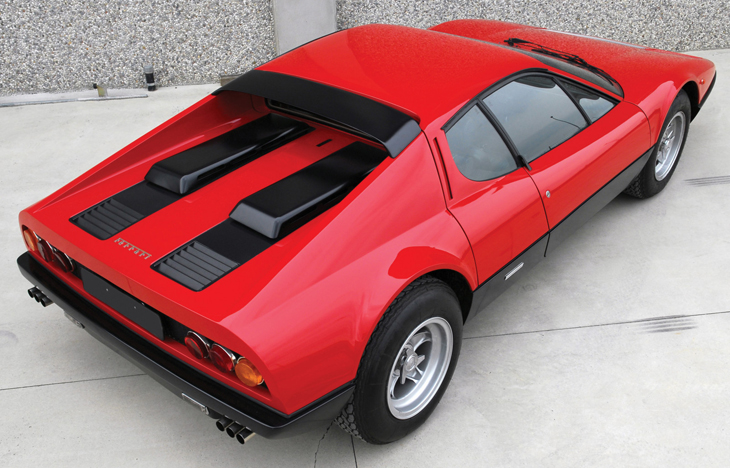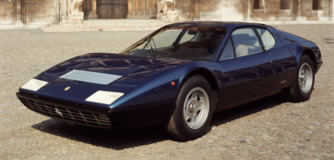|
Ferrari already had vast experience of the mid-engine layout with their single-seater and sports-racing models, together with the two 365P "Tre Posti" (three seat) concept road cars produced by
Pininfarina in 1966, and the V6 Dino series. However, the 365 GTB4 "Daytona" was selling well, and the factory no doubt thought it prudent to show the new car early, and assess client reaction to what was a radically
different top of the range model, and also give them time to test it extensively. When the 365 GT4BB did go into production, the "Daytona" continued in production alongside it for a few months. Between 1973 and 1976 a
total of 387 examples were produced.
The model title followed standard Ferrari practice, with the number "365" referring to the swept volume of a single cylinder, the number "4" relating to the total
number of camshafts, and the "BB" suffix stood for "Berlinetta Boxer". The "Boxer" part of the model name was a reference to the opposing banks of cylinders' operating order. However, the name was more an
analogy with the company's flat-12 Formula One engines, as the engine of the 365 GT4BB did not operate in true boxer engine sequence, where opposing pistons travel in opposite directions as the crankshaft rotates. As with the
365 GTB4, which became commonly referred to as the "Daytona", so the 365 GT4BB and the subsequent 512 development models, have generally been called "Boxers". Due no doubt, at least in part, to the tongue
tripping numbers and letters model designation.
Visually the forward section of the model was based on the extreme wedge Pininfarina P6 mid-engined concept car, presented at the Turin Show in 1968. The lower section of
the nose featured a full-width aluminium egg crate radiator grille, with driving lights behind it, from the top edge of which an indent line ran around the body perimeter, visually creating an upper and lower half to the body.
This was made even more evident, as the standard paint finish below this line was satin black. This satin black bottom body section subsequently became an option on other models, and was referred to as the "Boxer"
paint finish.
Above the nose was a one-piece, forward- hinged, front lid/wing assembly which had rectangular flush-mounted turn indicator light panels close to the forward edge. Behind these were twin retractable
headlights in rectangular pods, either side of the plain aluminium finished radiator exhaust air louvre panel. The five-window cabin section had a teardrop shaped side window profile, and the rear screen was a shallow vertical
flat panel, bounded by the buttresses of the one piece, rear hinged, engine cover with a stubby vertical tail. A satin black finished aerofoil was mounted just behind the cabin roof, bridging the sail panel buttresses, whilst
the engine cover featured rows of black exhaust air louvres and twin raised rectangular sections over the carburettor air filter boxes.
The tail-light treatment followed that of the 365 GTC4, with triple circular units,
fitted in a recessed mesh covered panel. The lighting layout was echoed in the bank of small triple chrome plated exhaust tail pipes, projecting through either side of the lower tail panel. The doors, front and rear lids had
aluminium panels, whilst the cabin frame was steel, with fibreglass lower nose and tail sections. Because of the low angle of the windscreen a tinted strip was provided across the top edge, and it had the radio aerial embedded
in it. This was the first Ferrari road car to be fitted with a space-saver spare wheel, which lay in a recess below the front lid, leaving very little space for luggage in the shallow nose.
The bodies were mounted on a
2500mm wheelbase chassis that had factory reference numbers F 102 AB 100, all were numbered in the odd chassis number road car sequence. The construction followed the Ferrari principle of a tubular steel chassis frame with
cross bracing, and sub structures, to support the engine, suspension, and ancillary equipment. On this model a new dimension was added, in that the cockpit section steel panels became an integral part of the structure, to form
a rigid, virtually monocoque, central cell. The model was available in right- or left-hand drive form, although a USA market version was never produced. The standard road wheels were silver-finished five-spoke "star"
pattern alloy, with a knock-off spinner on a Rudge hub, covering large ventilated disc brakes with twin hydraulic circuits, and servo assistance. Four wheel independent suspension was via wishbones, coil springs, and hydraulic
shock absorbers, with twin rear units, was provided, together with front and rear anti roll bars.
The engine was the first flat-12 cylinder configuration fitted in a Ferrari road car, but maintained the same cubic
capacity of 4390cc, and 81mm x 71mm bore and stroke, of the 365 GTB4 model, and had factory type reference F 102 AB 000. It had twin overhead camshafts per bank of cylinders, although these were now belt driven, instead of by
chain as on earlier Ferrari 12-cylinder engines. This had the effect of simplifying the engine castings, and reducing mechanical noise, more important now that the engine was right behind the occupant's ears. The engine was
longitudinally mounted in unit with the five speed transmission, which was below the crankshaft, raising the centre of gravity of the complete unit, but making it compact lengthwise. Although part of the engine and gearbox
casings used the same casting, internally the two were entirely separate relative to their oil systems, the engine featuring a wet sump lubrication system. It was fitted with two banks of two triple choke Weber 40 IF 3C
carburettors, with a single distributor, driven off the left rear inlet camshaft and an electronic ignition system, to produce a claimed 380 hp.
Engine
- Type rear, longitudinal flat-12
- Bore/stroke 81 x 71 mm
- Unitary displacement 365.86 cc
- Total displacement 4390.35 cc
- Compression ratio 8.8 : 1
- Maximum power 265 kW (360 hp) at 7500 rpm
- Power per litre 82 hp/l
- Valve actuation twin overhead camshafts per bank, two valves per cylinder
- Fuel feed four Weber 40 IF3C carburettors
- Ignition electronic, single spark plug per cylinder
- Lubrication wet sump
- Clutch single-plate
Chassis
- Frame tubular steel
- Front suspension independent, unequal-length wishbones, coil springs, telescopic shock absorbers, anti-roll bar
- Rear suspension independent, unequal-length wishbones, coil springs, twin telescopic shock absorbers each side, anti-roll bar
- Brakes discs
- Transmission 5-speed + reverse
- Steering rack-and-pinion
- Fuel tank capacity 120 litres
- Front tyres 215/70 VR 15
- Rear tyres 215/70 VR 15
Bodywork
- Type two-seater berlinetta
- Length 4360 mm
- Width 1800 mm
- Height 1120 mm
- Wheelbase 2500 mm
- Front track 1500 mm
- Rear track 1500 mm
- Weight 1160 kg (dry)
Performance



< 1970's
|



